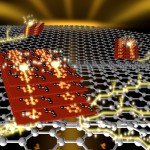 Carbon nanotubes, known since the late Nineties, are renowned for several characteristics, including a surprising electrical conductivity that can be about 1000 time higher than copper’s, even if much depends on their geometric structure. These same nanotubes if aggregated to form a fibre, essentially a light and very thin cable, cannot manifest the same property, while it would be very useful to have this type of cables for applications where weight is a fundamental element, for instance in aerospace ambit. The researchers of the Rice University in Houston have recently found the way to create some “nanotube-based cables” that grant four-time higher electric conductivity than copper’s, base for a new generation of a “light” power transmission. At Rice they have implemented conductive fibres with high sturdiness and flexibility, even if they have a diameter of 20 microns only, less than one human hair. They met difficulties in tests and measurements, since it is certain that there is a distance between engineers who work at electrical phenomena and those instead working in the science of materials, of carbon nanotubes in particular, hence a risk of heterogeneity in the assessment methodologies of the so called CCC (current carrying capacity), known as “ampacity, too, or current carrying capacity at permanent rate, to be meant as the maximum value of the current that can flow, in permanent state or under some determinate conditions, without the temperature exceeding a specified value; more precisely, the carrying capacity of a cable depends on the capability of the insulation of bearing temperature, on the parameters that influence the heat production, as well as the resistivity and the section of the conductor, and on the elements that condition the heat exchange between conductor and environment. Researchers have anyway analysed the CCC of their fibre by using a particular structure able to grant a comparison of consistency with electric cables. Among the next possible applications of carbon conductive fibres, the power supply of UAV, the Unmanned Aerial Vehicles, category to which the more and more diffused drones belong.
Carbon nanotubes, known since the late Nineties, are renowned for several characteristics, including a surprising electrical conductivity that can be about 1000 time higher than copper’s, even if much depends on their geometric structure. These same nanotubes if aggregated to form a fibre, essentially a light and very thin cable, cannot manifest the same property, while it would be very useful to have this type of cables for applications where weight is a fundamental element, for instance in aerospace ambit. The researchers of the Rice University in Houston have recently found the way to create some “nanotube-based cables” that grant four-time higher electric conductivity than copper’s, base for a new generation of a “light” power transmission. At Rice they have implemented conductive fibres with high sturdiness and flexibility, even if they have a diameter of 20 microns only, less than one human hair. They met difficulties in tests and measurements, since it is certain that there is a distance between engineers who work at electrical phenomena and those instead working in the science of materials, of carbon nanotubes in particular, hence a risk of heterogeneity in the assessment methodologies of the so called CCC (current carrying capacity), known as “ampacity, too, or current carrying capacity at permanent rate, to be meant as the maximum value of the current that can flow, in permanent state or under some determinate conditions, without the temperature exceeding a specified value; more precisely, the carrying capacity of a cable depends on the capability of the insulation of bearing temperature, on the parameters that influence the heat production, as well as the resistivity and the section of the conductor, and on the elements that condition the heat exchange between conductor and environment. Researchers have anyway analysed the CCC of their fibre by using a particular structure able to grant a comparison of consistency with electric cables. Among the next possible applications of carbon conductive fibres, the power supply of UAV, the Unmanned Aerial Vehicles, category to which the more and more diffused drones belong.



